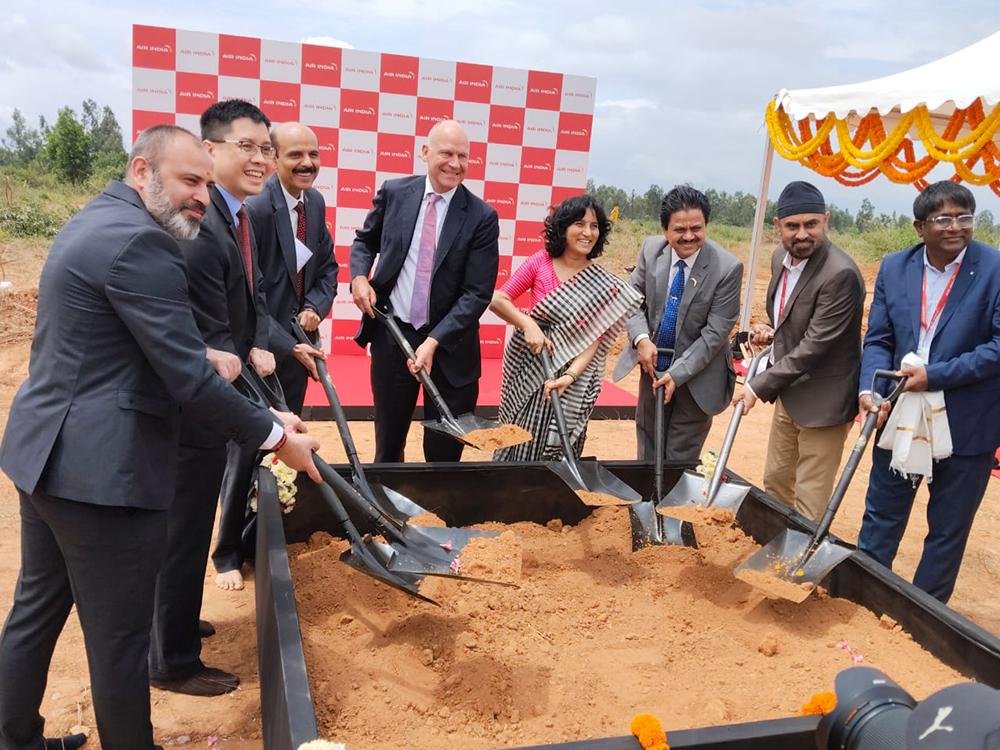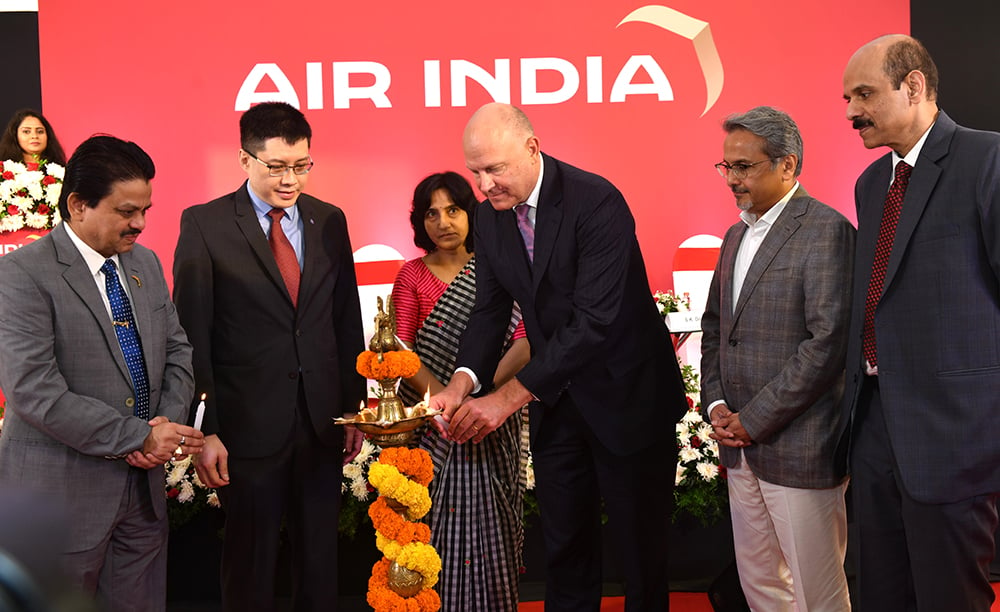
Air India CEO Campbell Wilson (center) says further investment in the facility may include additional hangars and a paint hangar.
Air India is leaving no stone unturned to develop its in-house line and base maintenance capabilities. The airline recently refurbished its widebody line maintenance hangar in Mumbai, and it also plans to build a new widebody hangar in Delhi to cater to the line maintenance requirements of its growing fleet.
“Delhi does not have a widebody hangar,” said Sisira Dash, chief technical officer at Air India. “If any Air India widebody aircraft has to undergo line maintenance, we have to send it to Nagpur or Mumbai facilities, leading to added cost for the airline. Hence, the new line maintenance hangar at Delhi will cater to the basic needs of line maintenance as the Air India fleet will soon swell up with the Vistara merger drawing closer. The widebody hangar at Delhi is expected to be operational by 2026.”
Speaking to Inside MRO at the groundbreaking ceremony of Air India’s new MRO facility at Bengaluru’s Kempegowda International Airport (BLR), Dash confirmed that the Bengaluru base maintenance facility will be spread across 35 acres and will have three widebody and nine narrowbody hangars.
“We will develop the capabilities in the new Bengaluru MRO starting with C checks on widebody and narrowbody aircraft. This will soon be followed by D checks on narrowbody [aircraft], gradually expanding the capabilities to D checks on widebody [aircraft],” Dash said, noting that the timeline to implement D check capability should take “a couple of years.” However, he said widebody D checks may take longer due to their complexity and the availability of skilled labor.

The Bengaluru facility has garnered an investment of 1,400 Indian crore ($167 million) for the development of Phase I. Speaking during the groundbreaking ceremony, Air India CEO Campbell Wilson said the facility will see further expansion and investment potential, including additional hangars and a new paint hangar.
Air India says the new facility will be equipped with the latest maintenance technology, including overhead teleplatforms, cranes, universal docking systems and the largest vertical lift hangar doors in the country.
Once completed, the facility is expected to create about 1,200 new jobs for skilled aviation engineers and support more than 200 small- and medium-scale enterprises in Karnataka through an enhanced supply chain. To generate more skilled labor, the airline also is planning an aviation maintenance training school in Bengaluru starting in 2025.
MRO Partnership Considerations
Meanwhile, SIA Engineering Co. (SIAEC), the engineering arm of Singapore Airlines, will plan, construct, develop and operationalize the Bengaluru facilities under an agreement signed in May. SIAEC CEO Chin Yau Seng expressed hope to collaborate on more future MRO projects with Air India.
SIAEC’s growing presence in India comes on the heels of the recent foreign direct investment approval on Singapore Airlines’ $276 million investment in the Air India-Vistara merged entity. Singapore Airlines is due to invest up to $675.42 million after the merger is completed, which is due by Nov. 12. Vistara will operate its last flight on Nov. 11, and then Air India will operate all of its aircraft.
The selection of SIAEC to build the MRO facilities is also a part of Tata-backed Air India’s extended plan to develop Bengaluru as its second aviation hub in the country, as the airline seeks to strengthen its operations beyond the capital. BLR achieved its record-high passenger traffic in fiscal 2024 with 37.5 million travelers, 32.86 million of which were domestic and 4.67 million international. The airport also continues to lead the perishable cargo sector in the Indian market with a total throughput of 439,524 metric tons in fiscal 2024, reflecting a notable 7.1% increase over the preceding financial year
Air India’s base maintenance previously was carried out by AI Engineering Services (AIESL), the airline’s engineering arm before its privatization. Now, as the general elections in India are over, the privatization of AIESL might take shape soon. Although it is rumored that Air India might bid to take over its erstwhile engineering arm by partnering with Lufthansa Technik (LHT), Air India’s recent collaboration with SIAEC has raised questions about its interest in buying AIESL. Now that Air India has found a new MRO partner, experts suggest the airline may ditch the AIESL deal if it is not lucrative enough.
Although Air India has been advancing plans to develop in-house line and base maintenance capabilities, it has also grown deals with third-party MRO providers. It recently signed a 12-year inventory technical management agreement with SIAEC to support its Airbus A320 family fleet, as well as a multiyear total component support agreement with LHT for its Boeing 777 fleet. The airline also has secured a long-term agreement with Honeywell for auxiliary power unit aftermarket support for its new and existing fleet.





